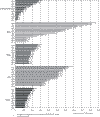|
|
AIR POLLUTION IN THE CZECH REPUBLIC IN 2001 Czech Hydrometeorological Institute - Air Quality Protection Division |
|
|
|
|
1. ATMOSPHERIC POLLUTANTS EMISSION IN THE CZECH REPUBLIC
Pursuant to the current legislation air pollution sources are divided into four categories. Complying with this categorisation, the ISKO system operated by CHMI includes REZZO 1–4 databases (Register of Emissions and Air Pollution Sources) which serve for archiving and presenting data on stationary and mobile air pollution sources. Large and medium-sized sources are monitored individually (point-source pollution), small sources at local level (area sources) and mobile sources at national level (line sources).
I. Large pollution sources - REZZO 1 The category of large sources included about 2,200 sources. The data used in the 2001 emission inventory of air pollutants from large sources was extracted from the Operational Inventory of Large Pollution Sources submitted by source operators to the Czech Environmental Inspection Office (ČIŽP) which is in charge of data collection and verification. The REZZO 1 database has been updated, i.e.additional operating technical data on sources (information on boilers, fuel consumption and quality and technologies), using the form sheets submitted by operators as Summary Evaluation of Data from the Operational Inventory under Decree No. 117/1997 of the Ministry of the Environment, in cooperation with ČIŽP. The medium-sized sources category includes data on more than 30,000 medium-sized sources. The 2001 results are based on the Operational Inventory of Medium-sized Pollution Sources, as verified by the district and municipal authorities� environment departments. The REZZO 2 database has been updated, i.e. additional operating technical data on sources (information on boilers, fuels, technologies and emissions), using the supplementary data from the Summary Evaluation of Data from the Operational Inventory under Decree No. 117/1997 in cooperation of the Emission and Sources Department of CHMI in Milevsko with the relevant district and municipal authorities� environment departments. Emissions from small sources (local heating units) have been inventoried based on the 1991 General Census; its output includes information on the consumption of principal fossil fuels in households. Emission was calculated from updated figures on fuels consumption based on data on the way of household heating, on specific heat consumption and climatic conditions in 2001. Inventories of emissions from transport, falling within the competency of the Ministry of Transport and Communications, have been processed by the Transport Research Centre (CDV) Brno for the year 2001. This new method was used also for the recalculation of data on transport emissions for the previous years beginning from 1990. Moreover, emissions from the groups of sources have been added (agricultural and forest machines, building machines etc. for the years 1994–1996). Table 1.1 documents total emissions of principal air pollutants in 2001, and namely, solid particles SO2, NOx, CO and shares contributed by each of the emission source categories monitored to total air pollutant emissions. International emission inventories (EMEP/CLRTAP, CORINAIR, EUROSTAT/OECD) require balances of volatile organic compounds (VOC). Pollutants presented as hydrocarbon emission (CxHy) shown in the Table 1.1 in previous years, do not correspond with pollutants presented as VOC. VOC emission balance is recorded differently and it includes also emission from the solvent use and paint application in sources not registered in REZZO database – outdoor and domestic paint and solvent use. Therefore data on total VOC emission and re-calculated VOC emission values for previous years are presented (see Fig. 1.1). This change corresponds also to the modification of the list of pollutants in the Supplement No. 1 to the Decree No. 117/97 under the Decree issued by the Ministry of the Environment No. 97/2000 of 10 April 2000. The development of total emission of principal pollutants in 1990–2001 is shown in Fig. 1.1. The table was produced with respect to the revised data on emissions from small sources in 1990–1995 and on NOx emissions from significant combustion sources in 1990–1995; the data calculated from fuel consumption levels were replaced by average data based on emission measurements. Data on all pollutants from mobile sources have been also revised. The level of emissions of basic pollutants has been stable in the recent three years, the emission decrease is connected with the finished reconstruction of significant stationary sources and the implementation of environmental measures. Moderate increase of NOx emissions is connected mainly with further increase of road transport. Table 1.2 presents emissions of greenhouse gases with direct radiative absorbing effect for the years 1990 and 1996–2000. The values shown in the table were recalculated to the equivalent amount of CO2 using the standard coefficients for the whole monitored period (1995 Global Warming Potential) defined for the 100-year time horizon, i.e. CO2 = 1, CH4 = 21, N2O = 310. The units of the values of substances containing fluorine are 1000x lower than in case of other gases. The values of CO2 include also the uptake from forestry. Table 1.3 covers heavy metal and POPs emission recorded within international co-operation in 1990–2001 with the use of capacity data (fuel consumption, heat supplied, statistical data on selected production technologies) and of the respective emission factors. Lead emissions from transport, and consequently, total emissions were recalculated. Marked decline of total lead emissions is caused by the decrease and subsequent total termination of leaded petrol sale in 2001. Table 1.4 demonstrates the consumption development of principal fuels in the period 1990–2000. A trend of marked decrease in brown coal and residual oil consumption by large emission sources has contributed to a long-term decline in SO2 and particulates, mainly in the 1990–1996 period. The development of consumption of principal fuels of REZZO 3 sources between 1990 (data based on the inventory carried out by TECO Milevsko) and 2001 is shown in Fig. 1.2. Changes in residential heating in 1991 (data provided by General Census) and 2001 (updated situation) are shown in Fig. 1.3. Emission data processed into emission density charts with the help of GIS is shown in Figs. 1.4, 1.5, 1.6 and 1.7, in which emission densities for solid particles, SO2, NOx and VOC are plotted in 5x5-km grid-squares. The charts are based on current emissions from stationary sources (REZZO 1 to 3) and line sources (REZZO 4) for 2000, with regional disaggregation of emissions from line sources according to the 1995 vehicle census. Among the most polluted regions of the Czech Republic with regard to emissions of principal air pollutants are counted continuously the region of the Capital City of Prague, Ústí nad Labem Region and Moravian-Silesian Region. Comparison of the specific emissions from stationary sources data in 1995 and 2001 (Table 1.5 and Table 1.6) shows that also in case of this coefficient expressive improvements occurred, especially reduction of SO2 and particulate emission. Development of emissions from large sources in the regions mentioned above in 1990–2001 is shown in Figs. 1.8, 1.9 and 1.10. Tab. 1.1 Total emissions of principal air pollutants in 2001 Tab. 1.2 Total emissions of greenhouse gases, 1990 to 2000 Tab. 1.3 Total emissions of HMs and POPs between 1990 and 2001 Tab. 1.4 Fuel consumption in REZZO 1 sources between 1990 and 2000 Tab. 1.5 Specific emission from stationary sources in 1996 (REZZO 1–3) Tab. 1.6 Specific emission from stationary sources in 2001 (REZZO 1–3) Fig. 1.1 Total emissions of principal pollutants in the Czech Republic between 1990 and 2001 Fig. 1.2 Fuel consumption in REZZO 3 sources, 1992-2001 Fig. 1.3 Changes in residential heating in 2001 as compared to 1991 Fig. 1.4 Particulate emission density from 5x5 km squares, 2000 Fig. 1.5 Sulphur dioxide emission density from 5x5 km squares, 2000 Fig. 1.6 Nitrogen oxide emission density from 5x5 km squares, 2000 Fig. 1.7 CxHy emission density from 5x5 km squares, 2000 Fig. 1.8 Annual emissions of principal pollutants from REZZO 1 stationary sources between 1990 and 2001 in Prague Fig. 1.9 Annual emissions of principal pollutants from REZZO 1 stationary sources between 1990 and 2001 in Ústí nad Labem Region Fig. 1.10 Annual emissions of principal pollutants from REZZO 1 stationary sources between 1990 and 2001 in Moravian-Silesian Region
|





